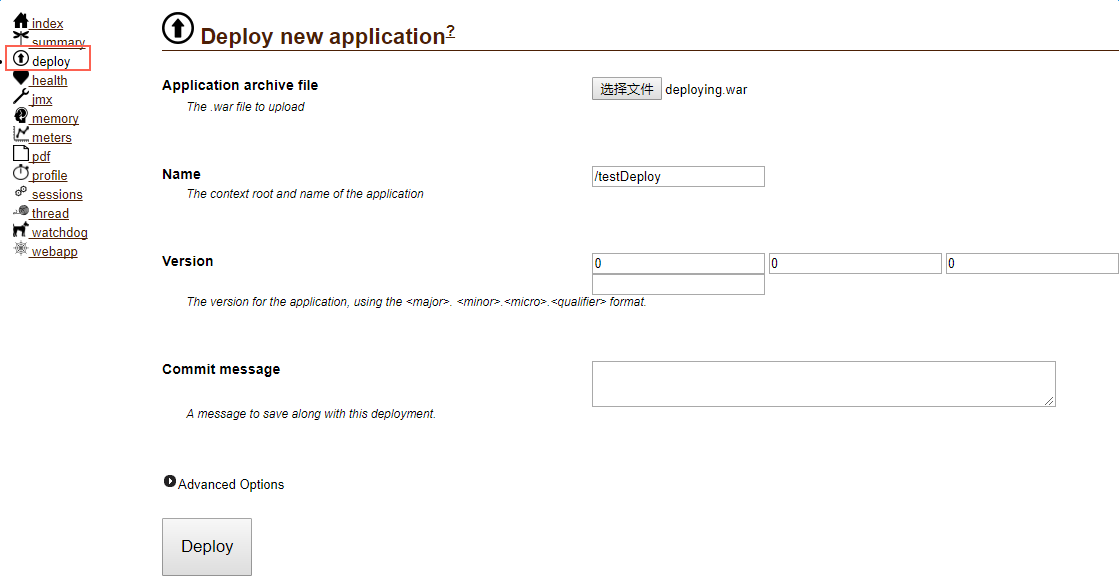写在前面,推荐下载resin4.0.47版本。其它版本没有测试
最近打算做一个小项目,然后容器选用了resin。想通过web提交war文件的方式 进行部署,更新代码也方便。
试了resin最新的版本(目前最新版本为4.0.53),提交war文件到webapps下面都是.tmp文件。百度google一通还是没找到解决办法。
看了下公司用的resin版本,选择4.0.47。下载后发现没最新版本的上传问题。
通过web提交war文件方式步骤如下:
步骤一:修改resin.properties。推荐配置如下
resin.properties
# resin.properties - configuration variable values
#
# See resin.xml, cluster-default.xml, and health.xml for full configuration.
# Any variable defined by ${...} can be set as a property in this file.
#
# Individual server overrides can be specified by prepending the server.id.
# For example, increasing the log level for an individual server:
#
# log_level : info
# app-0.log_level : finest
#
# Like Resin XML configuration, modification of this file will trigger
# a restart.
#
# General log level (modify resin.xml for more granular log level adjustments)
# log_level : finer
# Enable verbose browser error reporting
dev_mode : false
# How often Resin should check for updated files.
# dependency_check_interval : 5m
# Enable /resin-doc Resin documentation
resin_doc : false
resin_doc_host :
# List Triad server ip-addresses:hmux-port for each tier, space separated
# App tier Triad servers must be listed to enable web-tier to
# app-tier load-balancing
# web-tier Triad servers: web-0 web-1 web-2
# web_servers : 127.0.0.1:6810
# app-tier Triad servers: app-0 app-1 app-2
app_servers : 127.0.0.1:6800
# Configures Resin for a memcached server tier
# memcached-tier Triad servers: memcached-0 memcached-1 memcached-2
# memcached_servers : 127.0.0.1:6820
# memcached_port : 11211
# proxycache tier: proxycache-0 proxycache-1 proxycache-2
# proxycache_servers : 127.0.0.1:6830
# backend_servers : 127.0.0.1:80
# Allow elastic nodes to join the cluster (enable for cloud mode)
# elastic_cloud_enable : true
# The cluster that elastic nodes should join - each will contact a Triad server
# Use a separate resin.properties file for each cluster
home_cluster : app
# Used for an elastic server to join the cluster in home_cluster
# elastic_server : true
# Create a distinct webapps/ directory for each server, for vertical scaling
# elastic_webapp : true
# Used for cloud servers with dynamic IP addresses where the DNS name for the
# server is assigned after the server starts. Resin will retry the start.
# elastic_dns : true
# specifies the --server in the config file
# home_server : app-0
# Set HTTP and HTTPS bind address
# http_address : *
# Set HTTP and HTTPS ports.
# Use overrides for individual server control, for example: app-0.http : 8081
app.http : 80
app.https : 8443
web.http : 80
# web.https : 8443
# memcached.http : 8080
# memcached.https : 8443
# proxycache.http : 8080
# proxycache.https : 8443
# For security, Resin can switch to a non-root user after binding to port 80
setuid_user :
setuid_group :
# Arg passed directly to the JVM
jvm_args : -Xms1500m -Xmx1500m -XX:PermSize=206m -XX:MaxPermSize=206m
# jvm_args : -Xmx2048m -XX:MaxPermSize=256m
jvm_mode : -server
# This classpath has priority over the default classpath, like when you want to
# use a third party library like Hibernate's JPA
# jvm_classpath :
# Local URLs for the watchdog to check to ensure the server is up,
# space separated
# http_ping_urls : http://127.0.0.1/test.jsp
# Throttle the number of active threads for a port
port_thread_max : 1000
accept_thread_max : 1000
accept_thread_min : 200
keepalive_max : 512
# Enable JNI TCP speed optimizations
tcp_cork : true
sendfile : true
keepalive_select_enable : true
# OpenSSL certificate configuration
# Keys are typically stored in the resin configuration directory.
# openssl_file : keys/test.crt
# openssl_key : keys/test.key
# openssl_password : changeme
# openssl_protocols : -sslv2 -sslv3
# JSSE certificate configuration
# Keys are typically stored in the resin configuration directory.
# jsse_keystore_type : jks
# jsse_keystore_file : /etc/resin/keys/server.keystore
# jsse_keystore_password : changeme
# In absence of a signed certificate, Resin will fallback to using a
# self-signed development certificate if HTTPS is enabled
# Enable the proxy-cache - for caching static content in memory
proxy_cache_enable : false
# Sets the proxy cache memory size
# proxy_cache_size : 256m
# Enable clustered persistent sessions (for failover)
session_store : true
# disable the quercus *.php mapping when using Apache for PHP
# quercus_disable : true
# Web-apps named with numeric suffixes, e.g. foo-10.0.war and can be browsed
# as /foo. When a new version of the web-app is deployed, Resin continues
# to route active session requests to the previous web-app version while
# new sessions go to the new version, so users will not be aware of the
# application upgrade.
# webapp_multiversion_routing : true
# Set the email address to receive weekly and restart PDF reports
# email : admin@example.com
# pdf_summary : true
# Set a global password to prevent foreign Resin instances from connecting.
# Must be identical between web, app, and cache clusters.
# cluster_system_key : changeme
# Enable remote admin (for remote CLI and for EC2 ext: triad discovery)
# remote_admin_enable : true
# Enable /resin-admin web administration console
web_admin_enable : true
web_admin_host :
# Permit access to /resin-admin from non-local network ip-addresses
web_admin_external : true
# Require HTTPS to access /resin-admin
# web_admin_ssl : true
# Enable Resin REST Admin
# rest_admin_enable : true
# Require SSL for REST Admin
# rest_admin_ssl : true
# Access to /resin-admin and remote CLI is password restricted.
# Use "resinctl generate-password" and copy/paste here to set the admin
# admin_user : admin
# admin_password : {SSHA}xxxxxxxx
# Enable reading EC2 user data as resin properties
# properties_import_url : http://169.254.169.254/latest/user-data
resin.xml
<host id="youryuming.com" root-directory="."> <web-app id="/" root-directory="webapps/testDeploy"/> </host>
步骤二:访问https://youryuming.com:8443/resin-admin/
tips:如果没有进行域名映射,使用服务器ip也可以
PS:为什么要使用https,注册不使用https也可以,通过youryuming.com:8443/resin-admin/ 也可以。后面进行上传war包就会提示需要使用ssl。为了避免麻烦索性直接通过https进行注册登录
点击create configuration file 后根据页面提示进行操作修改,这里不再赘述。
resin容器检测到有配置文件修改时,会进行自动重启,修改配置文件时,不用关闭resin或者重启。
步骤三:发布项目

每次部署项目,resin容器都会自动重启。不用手动重启,感觉很爽有没有。。。